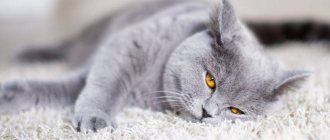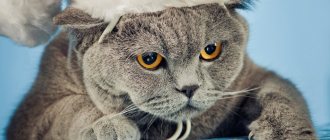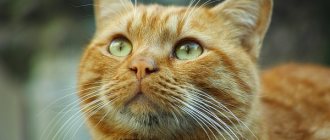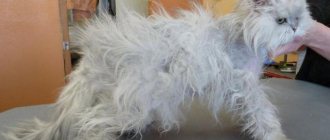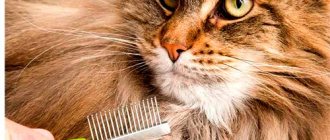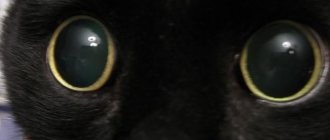Any cat health problem requires increased attention and involvement of the owner. Periocular alopecia is no exception - partial loss of hair, in which the ears and other parts of the pet’s body become bald. Often this phenomenon is caused by dangerous reasons, and it itself can become a sign of another, more serious disease.
Physiological causes of hair loss
Moderate hair loss is a natural process that does not always require treatment. The main reason for this phenomenon is annual molting, during which the old hair falls out and a new one grows in its place. It is noteworthy that cats lose much more fur than male cats.
Other causes of physiological hair loss:
- chafing collars, bandages or harnesses;
- bathing more often than once every 5 months;
- bathing with cheap human shampoos and detergents not intended for these purposes;
- stressful situation;
- age-related baldness in the area of the eyes, ears, paws, loss of mustache.
These causes do not pose any danger to the cat’s health and do not require treatment. As a rule, after a certain time, the fur grows back if the animal is not old.
Baldness in cats, how to deal with shedding: advice from a veterinarian
Seasonal shedding is normal. This period is especially noticeable for owners of long-haired pets. Molting can last from 2 weeks to 3 months. Veterinarians advise washing and combing animals more often during this time.
Be sure to read:
Sores on a cat’s neck that itch and hair fall out: normal or pathological, reasons, what to do
Effective shampoos against hair loss:
- "Phytoelite" from "Veda";
- SynergyLabs Shed-X Cat;
- Perfect Coat 8 in 1.
It is useful to take vitamin complexes, preferably in liquid form.
Bald spots in cats caused by hereditary causes cannot be treated.
To remove hair from the stomach, it is recommended to give special medications:
- Pet Naturals of Vermont;
- Actipet;
- Vaseline oil, etc.
Ordinary grass can help get rid of lumps; in the summer, it is enough for the animal to go for a walk; in winter, the seeds can be purchased at pet stores and planted yourself.
If shedding is accompanied by specific signs, it is necessary to show the cat to a doctor.
Signs of pathology
Alopecia is an anomaly that occurs due to a malfunction in the body and requires medical intervention. Large bald areas and bald spots on the pet's body should alert the owner.
Signs of pathology:
- severe hair loss during scratching and walking;
- the hair falls out in clumps, leaving bald areas in the area of the ears, back, tail and other parts of the body;
- the hair on one side is thicker than on the other;
- the skin on bald areas is not pinkish, as it should be normally, but red;
- peeling, ulcers, wounds and scabs are noticeable on the skin;
- the animal scratches the bald spot vigorously, possibly to the point of bleeding;
- touching the skin causes anxiety in the cat or, conversely, apathy.
If you notice one or more of the listed symptoms in your pet, take immediate action.
Remember that timely treatment is much more effective than therapy in severe stages of the disease.
Allergies
Allergies are the most common cause of bald spots; it causes cats to itch severely and start licking their fur. Over time, this excessive licking can lead to bald spots.
If your cat has an allergy, it can be caused by a variety of factors. Some cats may be allergic to something in their environment, such as dust or insect bites. These cats may require medication to treat allergies.
Other cats may have allergies to food or medications they take. Once you determine the cause of their allergies, you can change their food or medications and may not need treatment.
Causes of the disease
Baldness in cats, not associated with physiological hair loss, occurs for a number of reasons. It is not always possible to identify them by appearance, so a serious examination and appropriate tests may be necessary. In each individual case of baldness in cats, the veterinarian determines the possible causes and treatment individually.
Most often, pathology is caused by 3 groups of reasons:
- An allergic reaction to certain irritants: parasite bites, medications, odors or food.
- Hormonal imbalance: disturbance in the level of thyroid hormones, diabetes mellitus, problems in the functioning of the adrenal glands.
- Infectious diseases and parasites: seborrhea, abscesses, ulcers, fungus, scabies, ear mites.
In addition to these reasons, baldness in a cat can occur due to tumor processes or poor heredity. It is noteworthy that some hairless cat breeds were developed by crossing related individuals. Vitamin deficiency, viral diseases, ultraviolet radiation and some chronic diseases associated with the functioning of the gastrointestinal tract and liver also negatively affect the condition of the pet’s coat. In order to figure out why your cat is going bald, you need to consult a specialist.
Stress
Sometimes stress can cause a cat to go bald. If an animal finds itself in a dangerous situation, its home or owner has changed, the fur literally begins to fall off. If the animal has a balanced psyche and good health, then it will quickly adapt to new conditions, and then the problem will disappear. However, if the pet cannot come to its senses for a long time, then sometimes only sedatives can help.
It is better not to touch a cat that is experiencing stress. She must have a place where she can feel safe. You can build a relationship with your new pet through food and toys. You can place your personal item where the cat sleeps so that it quickly gets used to the smell of its new owner.
Diagnosis of the disease
The main task of an owner who notices that his cat is balding in the ears, back, abdomen and other parts of the body is to contact a veterinarian for a subsequent examination and diagnosis of the root cause that caused this problem.
To diagnose alopecia, the following measures may be necessary:
- analysis of medical history;
- visual examination of the skin, ear and mucous membranes of the cat;
- microbiological examination of wool bulbs;
- blood tests;
- analysis of epidermal scraping;
- hormone analysis;
- Ultrasound;
- X-ray examination.
All these methods together will help identify the presence of a disease that negatively affects the cat’s fur.
Diagnosis of alopecia in different parts of the body
Only a doctor can determine why a cat is going bald. The basis of diagnosis includes medical history, visual examination, and microscopic examination of hair roots.
Be sure to read:
Why does a cat constantly scratch its chin: what kind of disease is it?
The pet's blood is examined and a scraping is taken from the skin. If a tumor is suspected, an x-ray or ultrasound is performed.
The diagnosis is partially helped by the localization of bald spots on a cat:
- Symmetrical baldness of the abdomen, thighs, sides, and front legs is a characteristic symptom of a skin disease.
- Due to stress, cats tear out hairs in the anus , on the back, paws, stomach, and inner thighs. This happens especially often in the following breeds: Siamese, Abyssinian, Himalayan.
- Hormonal disorders are usually indicated by alopecia on the bridge of the nose , base of the tail, hips, and chest. The skin ceases to be elastic.
- In the case of a lack of thyroid hormones, pet hair is easily pulled out in the pelvic area , on the stomach, chest and neck.
- Cancerous formations provoke bald spots on the stomach, chest, and paws . Oncology can cause complete hair loss.
- Vitamin deficiency is characterized by the appearance of small, round bald patches, which can unite. The skin in places where there is no fur is bright pink.
- Fungal infections are characterized by the appearance of bald spots with scaly, cracked skin.
Scratching a pet's skin is dangerous due to infection and the development of an inflammatory process.
To make it easier for you to determine the cause of your pet's baldness, we have prepared a table. It contains all the main pathologies accompanied by hair loss in a cat:
Treatment options
Having determined the diagnosis, the specialist prescribes treatment. It is aimed at restoring the coat, as well as neutralizing the cause of baldness in the cat.
Treatment methods:
- If the problem is related to an allergic reaction, the animal must be completely protected from the allergen. After this, medications are prescribed to improve immunity. If the allergy is caused by food, then it is necessary to put the cat on a diet.
- Skin lesions from mites and lice must be treated with special antiparasitic drugs. The diet includes vitamins and nutritional supplements to strengthen the immune system.
- If a bald spot on a cat’s body appears due to an infectious disease, the doctor will prescribe a course of antibiotic therapy. As a rule, Amoxicillin is used for this.
- Baldness caused by stress in an animal is treated with special sedatives.
- Alopecia caused by demodicosis is treated by bathing with sulfur-selenium shampoo (1%).
- If the veterinarian has diagnosed ringworm, then treatment is carried out with the following drugs: Ketoconazole, Itraconazole, Griseofulfin, and so on. In this case, it is recommended to use immunosupportive agents and medications to improve metabolism. It is important to remember that ringworm is transmitted to humans.
- For endocrine disorders, hormonal drugs are prescribed.
- Skin abscesses are treated with local or systemic antibiotics, as well as antiseptics.
Use medications prescribed by your veterinarian. Self-medication can harm the animal, especially if you use the wrong medicine or do not maintain the permissible dosage.
How to treat baldness, what to do, how to help at home?
Therapy for the disease is aimed at eliminating the causes of alopecia:
- For allergies, contact with the allergen is eliminated, the use of anti-allergy drugs, immunostimulants, and diet are effective.
- For parasitic lesions, shampoo, ointment, and spray are prescribed.
- Pyoderma and abscesses are eliminated by excision of the affected skin, antibiotics and antiseptics are used to treat wounds.
- Stressful conditions are corrected by taking sedatives.
- Malfunctions of the thyroid gland are treated with hormonal medications; if a tumor develops, surgery is prescribed.
- Bacterial folliculitis is treated with antibiotics, usually amoxicillin. The pet is washed with medicated shampoo.
- For ringworm, the hair needs to be cut, Ketoconazole, Itraconazole, Griseofulvin are taken orally.
Important! Bald spots in cats caused by hereditary causes cannot be treated.
Prevention
To prevent animals from becoming bald, it is recommended to take preventive measures. Such measures will preserve the cat’s skin and prevent the development of more serious diseases.
Prevention of baldness includes:
- timely vaccination;
- regular preventive examinations;
- rich in vitamins, balanced diet;
- protecting the cat from possible stress;
- favorable living conditions;
- regular antiparasitic treatment of the cat’s skin;
- animal hair care;
- protecting your pet from contact with sick animals.
Taking preventive measures is simple. The main thing is that this will protect your pet from prolonged suffering and subsequent treatment, because preventing a disease is always easier than dealing with complications.
Some tips for proper pet care
To prevent the occurrence of pathological diseases of the cat family, it is important to follow a number of simple rules:
- feed correctly. It is not recommended to give pets food from the common table;
- eliminate or minimize stress;
- avoid contact with infected animals;
- maintain all appropriate vaccinations;
- monitor the fur, ears, eyes and general condition of the animal;
- Treat the animal for parasites in a timely manner.
By regularly examining your pet and carrying out all the necessary procedures, you will maintain his health for many years.
Vitamin deficiency as a cause of alopecia
Quite often, a pregnant cat becomes bald near the tail. In this case, we are talking about a lack of nutrients - vitamins and microelements. A cat bearing kittens needs a special diet, taking into account the changing needs of the body. Alopecia in pregnant animals should be treated by changing their diet.
If the cat's diet consists of natural food, it should be supplemented with special fortified supplements. Dry food during pregnancy must be replaced with special products intended for pregnant cats. Such foods are distinguished by a large amount of vitamins and microelements that cover the body’s need for these substances.
Vitamin deficiency also affects small kittens and older animals. This problem occurs especially often in kittens taken from the street. Due to the lack of normal nutrition, the immunity of animals weakens, against which a number of diseases develop, including hair loss. In all cases, you can get rid of the symptom only by adjusting your diet.
You should consult your veterinarian about the need to administer special supplements to older animals (over 7 years old). The fact is that at this age, alopecia may be a consequence of systemic disorders that need to be identified and, if possible, corrected.
Where did hairless cats come from?
You will experience the first shock when you first look at the Sphinx. You will not remain indifferent! The second shock is the feeling of a hot body in your hands. Whoever picks up the sphinx even once will never let it go.
What do we know about these amazing cats?
The first historical mentions of hairless cats date back to the times of the Aztecs. More recent information about them was found in India and Morocco, as well as in Paraguay. In the 60s of the 20th century, the first hairless cats were bred in Canada through the joint efforts of Canadian and French felinologists. The breed was named "Canadian Sphynx".
Canadian Sphynx Photo: George Balatsos, ru.wikipedia.org
In Toronto, a hairless kitten was born among the kittens of an ordinary domestic cat. Subsequently, he was crossed with his own mother - and again the litter ended up with hairless kittens. Some time later, in 1975, in the USA, the situation repeated itself: a hairless kitten was born from a simple cat, not without humor called Epidermis.
So gradually, by crossing rare representatives of these individuals, the number of sphinxes grew, and the result was not slow to show: today the Canadian Sphynx breed is one of the most popular. Canadian Sphynxes are not always completely hairless: they may have residual hairs on the muzzle, ears and tip of the tail, although there are also completely hairless specimens. But they don’t have whiskers—an essential cat attribute!
“Canadians” are quite muscular, strong, they have a wide and well-developed chest, slender but strong legs and a muscular neck. The ears are very large and widely spaced.
Despite the lack of hair, the Canadian Sphynx is a strong, resilient breed. The first representative of this breed lived 28 years! By nature, Sphynx cats are friendly, affectionate, sociable cats that need contact with their owners.
Photo: Depositphotos
But the Canadian Sphynx is not the only representative of hairless cats. In 1987, Elena Kovaleva, a resident of Rostov-on-Don, found a kitten on the street that had practically no hair. The fluff was only on the paws, tail, behind the ears and on the chest. Elena mistook the hungry abandoned kitten for a sick one, took pity on him and took him home. The cat was named Varvara, and a few years later she gave birth to kittens from an ordinary cat, Vasily. What is most surprising is that among the kittens there were also “naked” specimens.
It became clear that this was not Varvara’s defect, but a stable genetic mutation. Most likely, this mutation arose under the influence of environmental factors and was inherited by the kittens.
Since the ancestors of the foundling are unknown, the cat Varvara can rightfully be considered the progenitor of the “tribe” of hairless cats in Russia. As a result of the persistent and painstaking work of Russian felinologists for many years, by 1998 a new unique breed was approved - the “Don Sphynx”.
Despite the fact that this breed was officially recognized only in 1998, “Donchak” people have been involved in crossing and breeding new breeds of cats since the early 90s.
So, in 1994, Radmoy Von Jagerhoff's cat of the oriental breed gave birth to kittens from the Don Sphynx Afinogenes Mifa. For further selection work, four kittens were selected from the first two litters: Mandarin from Murino, Muscat from Murino, Nezhenka from Murino and Nocturne from Murino. These kittens became representatives of a new breed - the “Petersburg Sphynx”, or “Peterbald”.
In 1996, the breed was registered with the Breeding Felinological Federation. The Peterbald is a representative of the Siamese-Oriental group of cats and differs from the Don Sphynx in its more fragile and graceful physique.
One of the most attractive features of the Peterbald breed is its lack of aggressiveness and rancor towards humans or other pets. Peterbalds are very affectionate animals, even when dealing with infants.
Why were these cats called Peterbalds? The name of the breed comes from the English “peterbald” and means “bald Peter”. This word arose under the impression that the sculpture of Peter the Great resting in the Peter and Paul Fortress made on the creator of this breed, Olga Sergeevna Mironova.
Photo: Depositphotos
The Don and St. Petersburg sphinxes have long received international recognition and, along with the Canadian sphinxes, participate in exhibitions around the world. It is impossible to answer the question which breed is better. Sphynx cats don't need to be compared to other cats, you just need to love them!
Tags: Sphynx, hairless cats, cat breed, Peterbald, Don Sphynx, Canadian Sphynx, domestic cat, breed features, pets
Endocrine disorders
Causes of alopecia in animals include hormonal changes, metabolic disorders and obesity. If, after castration, the cat’s tail has peeled off at the base, this is a manifestation of hormonal alopecia. The same is true for cats that have recently undergone sterilization. The animal’s hormonal levels can normalize on their own, but in some cases drug therapy is necessary.
When metabolic disorders occur in overweight animals, hormonal imbalance is also observed. Such cats need dietary nutrition, the introduction of vitamin and mineral supplements into the diet and medication.
